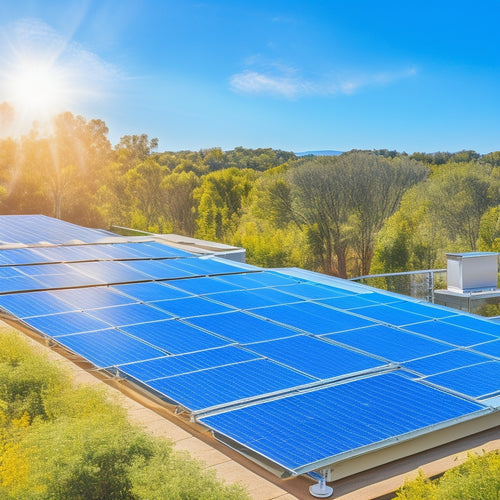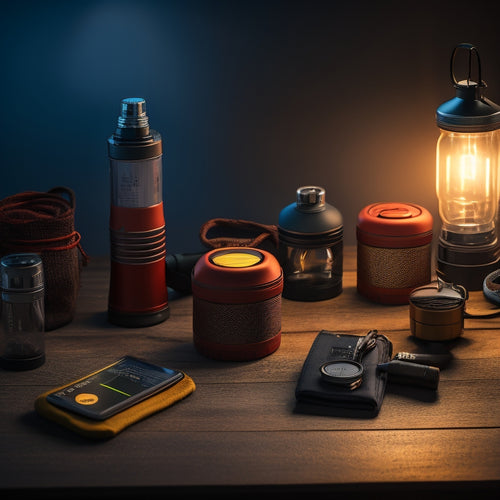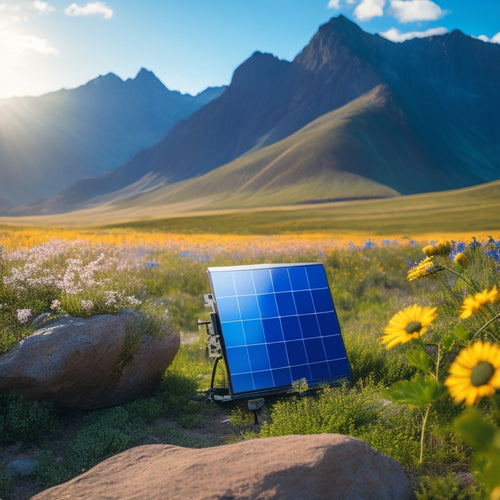
Sizing an Off-Grid Solar Panel System in 3 Essential Steps
Share
To size an off-grid solar panel system, you'll first assess your daily energy needs by listing appliances and their usage. Next, account for seasonal variations in sunlight to determine the appropriate panel capacity. Finally, select high-quality components, including batteries and inverters, that balance efficiency and long-term maintenance. Be certain to choose batteries based on their energy density and lifespan, as this affects your system's reliability. Proper sizing guarantees you meet your energy demands sustainably. Keep exploring options to optimize your setup and make informed decisions that best suit your energy lifestyle.
At a Glance
- Assess daily energy usage by listing appliances, their wattage, and daily operating hours to determine total energy needs.
- Consider seasonal variations in sunlight and energy consumption patterns to ensure the system meets peak demand throughout the year.
- Calculate the required solar panel capacity by dividing total daily energy needs by the average sunlight hours available in your location.
- Select appropriate battery storage based on energy needs and desired autonomy, factoring in battery type and lifespan considerations.
- Optimize system sizing to avoid oversizing or undersizing, ensuring efficient performance and reduced long-term maintenance costs.
Cost-Effective Energy Independence
When considering an off-grid solar panel system, you'll need to weigh the initial investment against the long-term savings potential.
Proper system sizing and power assessment are vital to avoid unnecessary costs and guarantee that your solar kit meets your energy demands.
Understanding the upfront costs, including equipment and installation, is key to achieving energy independence.
Initial Investment Considerations
Investing in an off-grid solar panel system requires careful consideration of upfront costs and potential long-term savings. You'll find that installation expenses can vary greatly based on system size, equipment quality, and site conditions. It's crucial to evaluate your financing options as you plan your investment, ensuring you choose a path that aligns with your budget and energy independence goals.
Here's a concise breakdown of typical initial costs associated with an off-grid solar panel system:
| Cost Component | Estimated Cost |
|---|---|
| Solar Panels | $1,000 - $3,000 |
| Inverter | $500 - $2,000 |
| Batteries | $1,200 - $5,000 |
| Charge Controller | $200 - $800 |
| Installation Labor | $1,000 - $3,000 |
As you assess these components, consider not only the immediate financial impact but also the implications for your energy autonomy. By carefully evaluating these initial investment considerations, you can make informed decisions that pave the way to a sustainable, self-sufficient lifestyle.
Long-Term Savings Potential
A well-designed off-grid solar panel system can greatly reduce your long-term energy costs, offering a pathway to financial independence. By utilizing the sun's energy, you can eliminate or greatly decrease your reliance on traditional energy sources, which often come with escalating fees.
As you invest in solar technology, you're not just purchasing equipment; you're securing a stable energy future.
Consider the available tax incentives, which can significantly lower your initial outlay. Many regions offer rebates or credits for renewable energy installations, making solar adoption even more financially attractive.
Additionally, investigate financing options customized for solar projects; these can reshape your upfront costs into manageable monthly payments, easing the shift to energy independence.
Over time, the savings on your energy bills can offset your initial investment. As energy prices continue to rise, you'll find yourself insulated from market volatility.
Ultimately, your off-grid solar system becomes a financial asset, allowing you to redirect savings toward other pursuits, whether that's travel, education, or simply a more comfortable lifestyle.
Sustainable Power Source Advantages
When you consider an off-grid solar panel system, the renewable energy source stands out as a primary advantage. Not only does it capture sunlight to generate power, but it also offers significant cost savings over time by reducing your dependence on traditional energy sources.
Renewable Energy Source
In recent years, renewable energy sources have gained significant traction as sustainable power solutions, offering numerous advantages over traditional fossil fuels. By utilizing the power of nature, you tap into energy that's abundant and inexhaustible. One of the most persuasive aspects of renewable energy is its potential to reduce your carbon footprint.
With ongoing solar energy advancements, you can now access technology that converts sunlight into electricity more efficiently than ever before. Moreover, renewable technology trends are driving innovation in energy storage, enabling you to store excess power for use during low sunlight periods. This flexibility enhances your energy independence, allowing you to rely less on grid-supplied power and more on your own energy production.
As you adopt these technologies, you're not just investing in a cleaner future; you're also contributing to the broader movement toward sustainable living. Additionally, the scalability of solar systems means you can customize your setup to fit your needs, whether you're powering a small cabin or a larger homestead.
Cost Savings Potential
Cost savings are one of the most persuasive reasons to invest in an off-grid solar panel system. By eliminating your dependence on grid connection, you can greatly reduce your utility bills and enhance your financial independence. While the initial investment may seem high, the long-term savings far outweigh the costs.
Here's a breakdown of potential savings:
| Expense Category | Cost Savings Potential |
|---|---|
| Monthly Energy Bills | $100 - $300/month |
| Grid Connection Fees | $50 - $150/month |
| Maintenance Costs | $0 - $20/month |
| Back-up Power Costs | $0 - $200/month |
| Financial Incentives | $1,000 - $10,000+ |
In addition to direct savings, you might qualify for financial incentives like tax credits or rebates that can further offset your system's cost. By going off-grid, you not only gain autonomy but also a chance to invest in your future. The freedom from fluctuating energy prices and the ability to generate your own power creates a sustainable financial model that enables you for years to come.
Key System Components Overview
When sizing your off-grid solar panel system, selecting the right solar panels and energy storage solutions is essential.
It's important to assess your energy needs by analyzing consumption patterns and determining the appropriate size and type of solar battery based on energy demands—assess energy needs.
You'll need to evaluate factors like efficiency, capacity, and lifespan to guarantee peak performance.
Understanding these components will help you create a reliable and sustainable energy source customized to your needs.
Solar Panels Selection
Selecting the right solar panels is essential for optimizing your off-grid solar panel system's efficiency and performance. You'll want to investigate various solar panel types, including monocrystalline, polycrystalline, and thin-film, each offering distinct advantages and efficiency ratings. Understanding these differences can help you make informed decisions that align with your energy needs and freedom aspirations.
| Solar Panel Type | Efficiency Rating | Pros |
|---|---|---|
| Monocrystalline | 15-22% | High efficiency, space-saving |
| Polycrystalline | 13-16% | Cost-effective, good performance |
| Thin-film | 10-12% | Lightweight, flexible design |
When selecting panels, consider your available space and power requirements. Monocrystalline panels may be ideal for limited areas but come at a higher cost. Polycrystalline panels are a solid middle-ground option if you seek balance in efficiency and price. Thin-film panels offer versatility but may require more space due to lower efficiency. By carefully analyzing these factors, you can choose solar panels that not only meet your energy needs but also enhance your off-grid lifestyle.
Energy Storage Solutions
Energy storage solutions play an essential role in ensuring the reliability and efficiency of your off-grid solar panel system. Without adequate storage, you can't utilize the full potential of your solar energy generation.
Battery technologies are at the forefront of this aspect, with lithium-ion, lead-acid, and newer options like flow batteries each offering distinct advantages depending on your needs.
Lithium-ion batteries, for example, provide high energy density and longer life cycles, making them ideal for energy efficiency in systems where space is limited. On the other hand, lead-acid batteries are more affordable upfront, but they typically require more maintenance and have shorter lifespans.
Understanding these trade-offs helps you make an informed decision about the best solution for your unique situation.
Integrating energy storage systems effectively means you'll have power available when sunlight isn't, granting you the freedom to live off-grid without sacrificing comfort.
It's vital to assess your energy usage patterns and select a battery solution that aligns with them. This approach maximizes both your energy independence and the efficiency of your solar panel system, ensuring you're prepared for whatever the day may bring.
Selecting Based on Energy Demand
To effectively size your off-grid solar panel system, you first need to determine your daily energy usage.
This assessment should consider seasonal variations in demand, as energy needs can fluctuate throughout the year.
Conducting a thorough energy auditing not only helps in understanding these patterns but also guarantees that your system is neither undersized nor oversized, thereby optimizing its performance.
Determine Daily Usage
Understanding your daily energy usage is vital for sizing an off-grid solar panel system effectively. To achieve this, you'll need to conduct an energy consumption analysis and a usage pattern assessment. Start by listing all the electrical appliances you plan to use, their wattage, and the estimated hours of daily operation. This will help you determine your total energy needs.
Here's a simple table to illustrate:
| Appliance | Wattage | Daily Usage (hrs) | Daily Energy Consumption (Wh) |
|---|---|---|---|
| LED Light Bulb | 10 | 5 | 50 |
| Refrigerator | 150 | 24 | 3600 |
| Laptop | 50 | 6 | 300 |
| TV | 100 | 4 | 400 |
| Water Pump | 200 | 2 | 400 |
Add up the daily energy consumption of each appliance to get your total daily usage in watt-hours. This figure is vital for determining the number of solar panels and battery storage you'll need to guarantee your off-grid system meets your energy demands.
Assess Seasonal Variations
When planning your off-grid solar panel system, it's crucial to assess seasonal variations in energy demand. Different seasons bring unique weather impacts that can greatly influence your solar system's efficiency.
For instance, summer might generate abundant sunlight, whereas winter could result in shorter days and increased cloud cover, affecting your energy production.
To evaluate these seasonal variations, analyze your energy consumption patterns throughout the year. Are there months when you rely more on electricity due to heating or cooling needs? Understanding this will help you determine how much energy you'll need during peak demand periods.
Moreover, consider the seasonal efficiency of your solar panels. Their output can vary based on temperature and sunlight availability.
For example, while solar panels generally perform better in cooler temperatures, they may experience decreased efficiency on cloudy days.
Lower Long-Term Maintenance Costs
When sizing your off-grid solar panel system, it's essential to evaluate how equipment wear impacts long-term maintenance costs.
By optimizing your system's capacity and ensuring it operates within its ideal range, you can greatly reduce the strain on components.
This proactive approach not only extends the lifespan of your equipment but also minimizes the frequency and costs of repairs over time.
Reduced Equipment Wear
Minimizing equipment wear is vital for maintaining the efficiency and longevity of your off-grid solar panel system. By carefully selecting components and optimizing their performance, you can markedly reduce wear and tear, ultimately leading to lower long-term maintenance costs.
Start by choosing high-quality, durable solar panels and batteries designed for the demands of off-grid living. These components will withstand environmental stressors and operate effectively over time, enhancing equipment longevity.
Regular monitoring and maintenance are also important; keeping your system clean and free from debris will improve overall performance optimization and reduce unnecessary strain on your equipment.
Additionally, consider implementing smart energy management practices. By avoiding overloading your system and distributing energy consumption evenly, you can minimize the wear on your batteries and other components. This proactive approach not only extends the life of your equipment but also guarantees that you maintain a reliable energy supply, granting you the freedom you desire in your off-grid lifestyle.
Ultimately, investing in quality components and adopting best practices will lead to a more efficient, long-lasting solar panel system, allowing you to enjoy your independence without the burden of frequent repairs.
Frequently Asked Questions
How Do I Determine My Energy Consumption Needs?
To determine your energy consumption needs, conduct an energy audit. Track your appliance usage, noting wattage and hours of operation. This'll help you understand how much energy you truly require for off-grid living.
What Is the Lifespan of Solar Panels?
Think of solar panels as your loyal companions on an expedition. With proper maintenance, they last 25-30 years, showcasing impressive durability. Regular checks guarantee they perform efficiently, granting you energy independence for years to come.
Can I Expand My Solar System Later?
Yes, you can expand your solar system later. By prioritizing system scalability during installation, you'll facilitate future upgrades, ensuring your setup can adapt to increased energy demands and support your desire for energy independence.
What Permits Do I Need for Installation?
Maneuvering the labyrinth of permits can feel intimidating. To guarantee a smooth installation, you'll need to check local regulations and adhere to installation guidelines. Always stay informed to maintain your freedom in renewable energy choices.
How Does Weather Affect Solar Energy Production?
Weather variability greatly impacts solar efficiency. Cloud cover, rain, and snow reduce sunlight, leading to decreased energy production. Understanding these factors helps you better anticipate energy needs and optimize your off-grid system for consistent performance.
Explore More
To summarize, sizing your off-grid solar panel system isn't just about meeting energy needs; it's a strategic move towards sustainable independence. By understanding your energy demand and selecting the right components, you're not only investing in cost-effective solutions but also reducing long-term maintenance costs. As you utilize the sun's power, you'll find that this investment coincides with a commitment to a greener future, ultimately creating a harmonious balance between personal energy security and environmental responsibility.
Related Posts
-

What Types of Solar Energy Devices Are Available
You'll find several types of solar energy devices available today, each customized to different energy needs. Photovo...
-

Best Solar Powered Flashlights for Emergency Situations
When you're choosing the best solar-powered flashlights for emergency situations, focus on their brightness, battery ...
-

High-Efficiency Solar Battery Chargers for Remote Areas
High-efficiency solar battery chargers are essential for your off-grid energy needs in remote areas. They maximize en...


